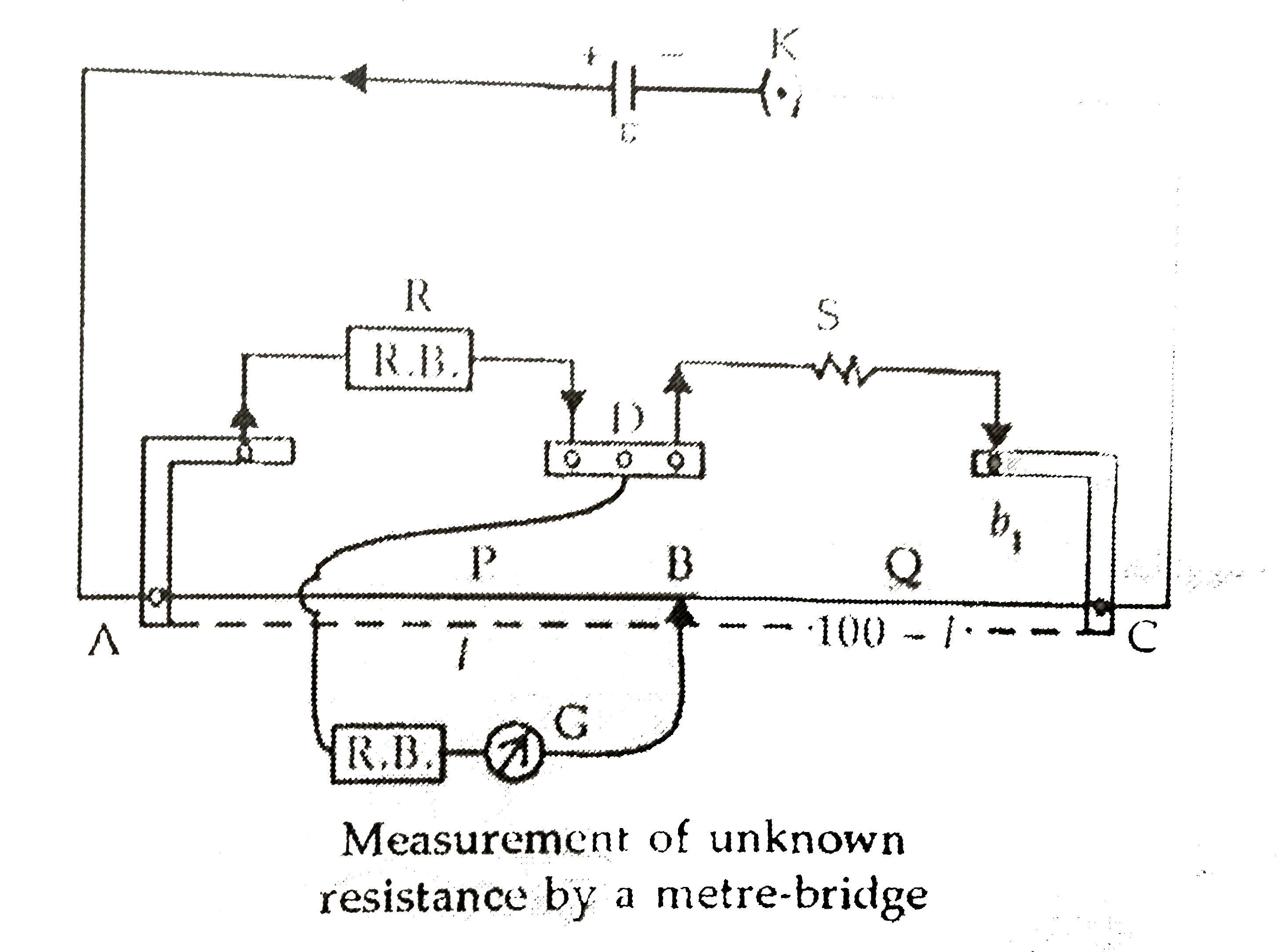State the underlying princeiple of mater bridge. Draw the circuit diagram and explain how the unknown resistance of a conductor can be determined by this method.
Metre bridge or slide wire bridge. It is the simplest practical application of the Wheatstone bridge that is used to measure an unknown resistance.
Principle : Its working is based on the principle of Wheatstone bridge. When the bridge is balanced,
PQ=RS
Construction : It consists of usually one metre long magnanin wire of uniform cross-section, streatched along a metre scale fixed over a wooden board and with its two ends soldered to two L-shaped thick copper strips A and C. Between these two copper strips, another copper strip is fixed so as to provide two gaps ab and a1b1. A source of emf ε is connected across AC. A movable jockey and a galvanometer are connected across BD, as shown in figure.
After taking out suitable resistance R from the resistance box, the jockey is moved along the wire AC till there is no deflection in the galvanometer. This is the balanced condition of the Wheatstone bridge. If P and Q are the resistances of the parts AB and BC of the wire, then for the balanced condition of the bridge, we have
PQ=RS.
Let total length of wire AC=100cm and AB=l cm, then BC=(100-l)cm. Since, the bridge wire is of uniform cross-section, therefore, resistance of wire ∝ length of wire
PQ=resistance of ABresistance of BC=σlσ(100−1)=l100−l
where σ is the resistance per unit length of the wire.
Hence, RS=l100−lor,S=R(100−l)l.

Topper's Solved these Questions
- XII BOARDSBOOK - XII BOARDS PREVIOUS YEARCHAPTER - XII BOARDSEXERCISE - SECTION - D
6 Videos
- XII BOARDSBOOK - XII BOARDS PREVIOUS YEARCHAPTER - XII BOARDSEXERCISE - SECTION - E
6 Videos
- XII BOARDSBOOK - XII BOARDS PREVIOUS YEARCHAPTER - XII BOARDSEXERCISE - [SET -III, OUTSIDE DELHI]
5 Videos
- SAMPLE PAPER 2019BOOK - XII BOARDS PREVIOUS YEARCHAPTER - SAMPLE PAPER 2019EXERCISE - SECTION D
6 Videos
Similar Questions
Explain the principle of working of a meter bridge. Draw the circuit diagram for determination of an unknown resistance using it.
View SolutionDraw the circuit diagram of a metre bridge to explain how it is based on Wheatstone bridge.
View SolutionDraw the circuit diagram for wheatstone bridge to determine unknown resistance. Write condition for balancing of the bridge.
View SolutionState briefly the underlying principle of a transistor oscillator. Draw a circuit diagram showing how the feedback is accomplished by inductive coupling. Explain the oscillator action.
View SolutionWith the help of a circuit diagram, explain the working principle of metre bridge. How is it used to determine the unknown resistance of a given wire ? Write the necessary precautions to minimise error in the result.
View SolutionWith the help of a circuit diagram, explain the working principle of a metre bridge. How is it used to determine the unknown resistance of a given wire? Write the necessary precautions to minimise the error in the result?
View SolutionDraw a circuit diagram of a meter bridge used to determine the unknown resistance R of a given wire. Hence derive the expression for R in terms of the known resistance S.
View SolutionWith the help of circuit diagram, explain how a meter bridge can be used to find unknown resistance of a given wire?
View SolutionTwo equal resistors are connected in series. Draw the circuit diagram for determining the resultant resistance.
View SolutionTwo equal resistors are connected in series. Draw the circuit diagram for determining the resultant resistance.
View Solution
